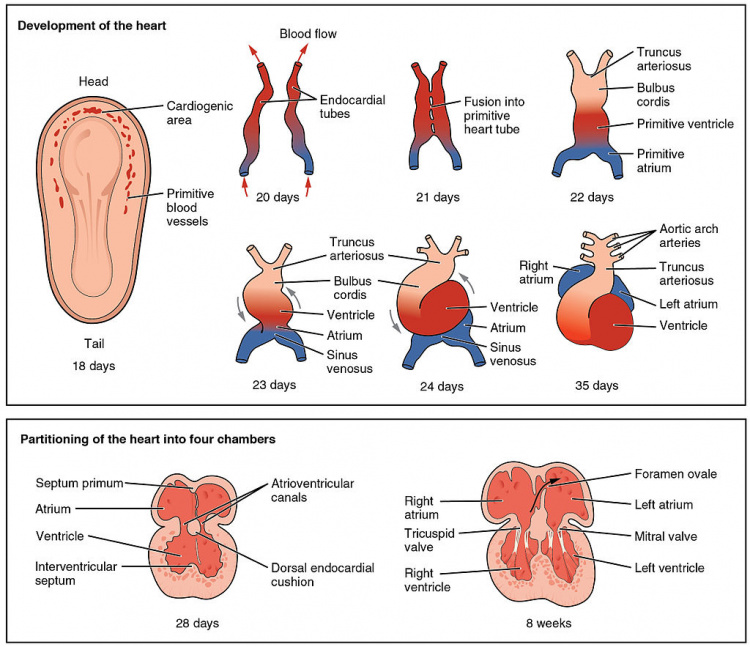2018 Group Project 4: Difference between revisions
No edit summary |
|||
| Line 6: | Line 6: | ||
The heart is a muscular organ which plays a critical role in the circulatory system by mechanically pumping blood to various organs around the body for the exchange of nutrients and gases. It is located at the center of the chest, right behind the sternum and is tilted slightly to the left. The heart has four different chambers which are compartmentalized by semilunar and atrioventricular valves into the left and right atria and ventricles | The heart is a muscular organ which plays a critical role in the circulatory system by mechanically pumping blood to various organs around the body for the exchange of nutrients and gases. It is located at the center of the chest, right behind the sternum and is tilted slightly to the left. The heart has four different chambers which are compartmentalized by semilunar and atrioventricular valves into the left and right atria and ventricles | ||
==Cardiac neural crest cells== | |||
. CNCCs are a subpopulation of cranial neural crest cells that originate from the dorsal neural tube between the mid-otic placode to the posterior border of somite three. CNCCs migrate ventrally, accumulate in the circumpharyngeal ridge, and then continue into pharyngeal arches three, four, and six as each arch develops successively (Fig. 2). The cells migrate between the pharyngeal ectoderm and endoderm, proliferate and fill the arches, and surround the endothelial strands of the forming pharyngeal or aortic arch arteries. The pharyngeal arch arteries develop as a bilaterally symmetrical series of vessels connecting the aortic sac to the paired dorsal aortas. Pharyngeal arch arteries 3–6 are re-patterned later in development into the asymmetric great arteries: the common carotid (right and left third pharyngeal arch arteries), the definitive aortic arch (right or left fourth pharyngeal arch artery), and the ductus arteriosus (right and/or left sixth aortic arch arteries) (Fig. 3). The fifth pharyngeal arch artery regresses.* The CNCCs will form the smooth muscle tunics of the great arteries (Bergwerff et al., 1998). The CNCCs are not necessary for initial formation of vessels from the endothelial precursors, but are required for subsequent artery remodeling (Bockman et al., 1987). | |||
==History of cardiac neural crest cells== | ==History of cardiac neural crest cells== | ||
Revision as of 09:03, 8 September 2018
| Projects 2018: 1 Adrenal Medulla | 3 Melanocytes | 4 Cardiac | 5 Dorsal Root Ganglion |
Project Pages are currently being updated (notice removed when completed)
Neural Crest and Cardiac Development
Introduction of the heart
The heart is a muscular organ which plays a critical role in the circulatory system by mechanically pumping blood to various organs around the body for the exchange of nutrients and gases. It is located at the center of the chest, right behind the sternum and is tilted slightly to the left. The heart has four different chambers which are compartmentalized by semilunar and atrioventricular valves into the left and right atria and ventricles
Cardiac neural crest cells
. CNCCs are a subpopulation of cranial neural crest cells that originate from the dorsal neural tube between the mid-otic placode to the posterior border of somite three. CNCCs migrate ventrally, accumulate in the circumpharyngeal ridge, and then continue into pharyngeal arches three, four, and six as each arch develops successively (Fig. 2). The cells migrate between the pharyngeal ectoderm and endoderm, proliferate and fill the arches, and surround the endothelial strands of the forming pharyngeal or aortic arch arteries. The pharyngeal arch arteries develop as a bilaterally symmetrical series of vessels connecting the aortic sac to the paired dorsal aortas. Pharyngeal arch arteries 3–6 are re-patterned later in development into the asymmetric great arteries: the common carotid (right and left third pharyngeal arch arteries), the definitive aortic arch (right or left fourth pharyngeal arch artery), and the ductus arteriosus (right and/or left sixth aortic arch arteries) (Fig. 3). The fifth pharyngeal arch artery regresses.* The CNCCs will form the smooth muscle tunics of the great arteries (Bergwerff et al., 1998). The CNCCs are not necessary for initial formation of vessels from the endothelial precursors, but are required for subsequent artery remodeling (Bockman et al., 1987).
History of cardiac neural crest cells
"In a chick study of parasympathetic innervation of the heart, Margaret Kirby and colleagues ablated neural crest and serendipitously discovered that the embryos lacked aorticopulmonary septation (Kirby et al., 1983). The subregion of cranial neural crest ablated by Dr. Kirby has been called the “cardiac neural crest”, not because the cells of this region migrate solely to the heart, but for the importance of crest-derived ectomesenchyme in cardiovascular development. "
